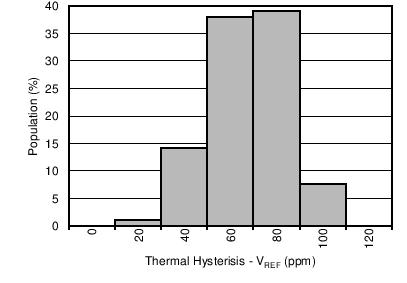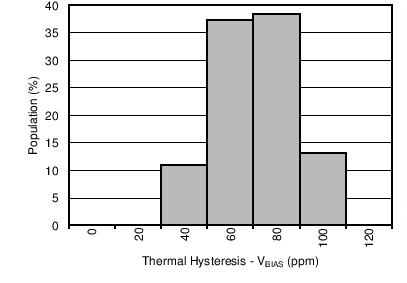SBOS600E July 2018 – February 2022 REF2025 , REF2030 , REF2033 , REF2041
PRODUCTION DATA
- 1 Features
- 2 Applications
- 3 Description
- 4 Revision History
- 5 Device Comparison Table
- 6 Pin Configuration and Functions
- 7 Specifications
- 8 Parameter Measurement Information
- 9 Detailed Description
- 10Applications and Implementation
- 11Power-Supply Recommendations
- 12Layout
- 13Device and Documentation Support
- 14Mechanical, Packaging, and Orderable Information
Package Options
Mechanical Data (Package|Pins)
- DDC|5
Thermal pad, mechanical data (Package|Pins)
Orderable Information
8.3 Thermal Hysteresis
Thermal hysteresis is measured with the REF20xx soldered to a PCB, similar to a real-world application. Thermal hysteresis for the device is defined as the change in output voltage after operating the device at 25°C, cycling the device through the specified temperature range, and returning to 25°C. Hysteresis can be expressed by Equation 1:
Equation 1. 

where
- VHYST = thermal hysteresis (in units of ppm),
- VNOM = the specified output voltage,
- VPRE = output voltage measured at 25°C pre-temperature cycling, and
- VPOST = output voltage measured after the device has cycled from 25°C through the specified temperature range of –40°C to 125°C and returns to 25°C.
Typical thermal hysteresis distribution is as shown in Figure 8-5 and Figure 8-6.
 Figure 8-5 Thermal Hysteresis Distribution (VREF)
Figure 8-5 Thermal Hysteresis Distribution (VREF) Figure 8-6 Thermal Hysteresis Distribution (VBIAS)
Figure 8-6 Thermal Hysteresis Distribution (VBIAS)